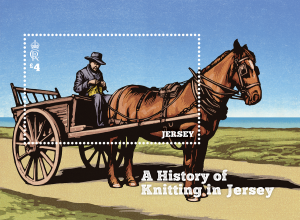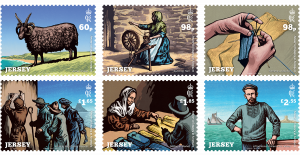A set of six stamps and a miniature sheet detailing Jersey’s industrious knitting past will be issued on the 2 November 2023.
Jersey was once famous for its knitwear trade with knitted items being the Island’s biggest export; namely, in the 1600s, fine knitted stockings and undergarments. Later in history, Channel Island techniques were influential in the development of the ‘Jersey’ fisherman’s jumper.
Historically an agricultural and fishing island, Jersey was strategically placed to benefit from the trade of wool exports from the mainland during the ongoing wars between England and Europe in the 17th century. An influx of materials at this time enabled the Jersey people to develop a flourishing system of production and export of fine knitted goods to Europe. Its quality goods were appreciated across Europe and England. Queen Elizabeth I was delighted to be gifted a pair of Jersey stockings by Sir Walter Raleigh (Lieutenant Governor of the Island at the time) and Mary Queen of Scots is said to have been wearing a pair of Jersey stockings at her execution.
It wasn’t uncommon to see men and children also partaking in the craft. One writer describes how “It was common to see men knitting whilst driving their (vraicing) carts. Such was the ardour of the people that the voice of the preacher in the pulpit, to which the law required them to listen every Sunday, could hardly be heard above the clicking of the needles.”
Among fears that this knitting craze would distract locals from working the land, which had for so long been the cornerstone of Jersey’s economy, in July of 1606 an Order of the States was enacted which banned every person over 15 years of age from knitting during vraicing season and the month of August, with a penalty of imprisonment on bread and water.
Jersey’s knitting industry saw its peak in the 17th century with the stocking trade but came to a gradual halt in the 19th century due to interrupted trade with the mainland, the advent of machine knitting and the development of newer, more profitable industries on the Island such as shipbuilding. Though a small Island with a vastly changed economy, Jersey’s legacy lives on; intricately woven into the threads of history that led to the knitwear we wear today.
For the first Jersey Industries Series issue, British artist Chris Wormell illustrated 2021’s popular Brewing in Jersey set. In this second issue, Chris illustrates the life of Island knitters at the height of the industry, as well as a fisherman in his ‘Jersey’ jumper. Each issue in this series includes a miniature sheet showcasing a working vehicle. The miniature sheet from this issue depicts a vraic harvester knitting in his horse-drawn cart.
This commemorative issue, entitled ‘A History of Knitting in Jersey’ will be available to buy from all branches of Jersey Post from 2 November 2023.
Philatelic stamp products such as miniature sheets, first day covers and presentation packs will be available from the Jersey post offices at Broad Street, St Helier and Rue Des Pres, St Saviour and can be ordered now at www.jerseystamps.com or by telephoning the Jersey Philatelic Bureau on: 00 44 (0)1534 616717.
Technical details: Illustrated by Chris Wormell. Stamps printed in four colour process lithography by bpost, Belgium. Stamp die size: 30mm deep x 40mm wide. Miniature sheet size: 88mm x 120mm, enclosing a 43.33mm x 70mm block perforated stamp. Stamp products © Jersey Post Ltd 2023.

 Åland
Åland  Faroe Islands
Faroe Islands  Gibraltar
Gibraltar  Greenland
Greenland  Guernsey
Guernsey  Isle of Man
Isle of Man  Jersey
Jersey  Liechtenstein
Liechtenstein  Luxembourg
Luxembourg  Malta
Malta  Monaco
Monaco  Vatican City
Vatican City 

